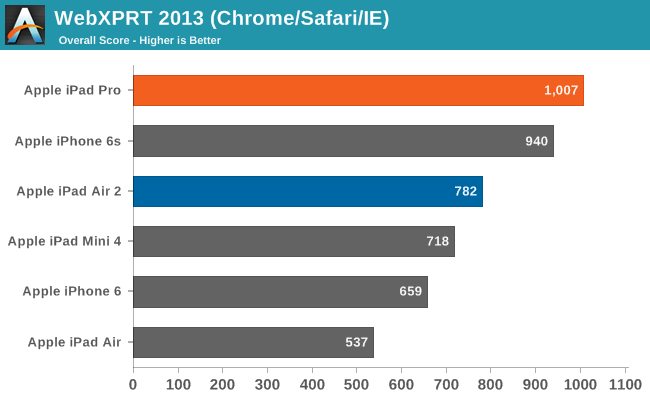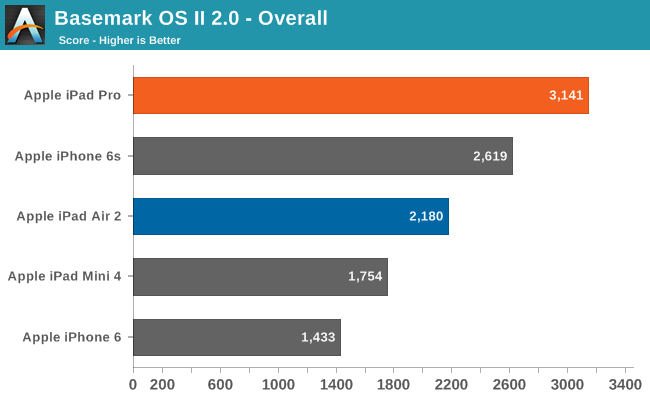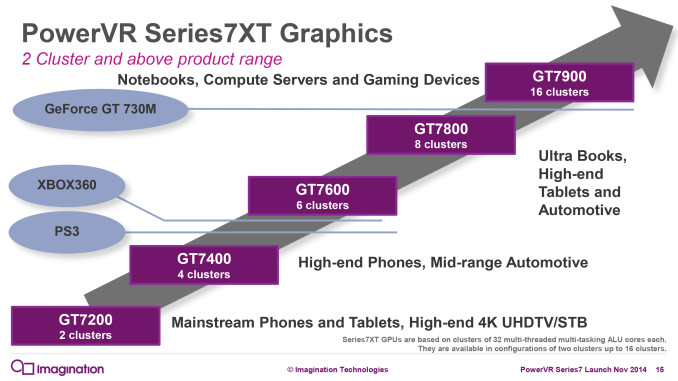The iPad Pro Preview: Taking Notes With iPad Pro
by Joshua Ho & Ryan Smith on November 11, 2015 7:00 AM ESTThe A9X SoC & More To Come
Finally, as everyone is undoubtedly eagerly anticipating our look at the A9X SoC inside the iPad Pro, let’s take a very quick look at what we know about the SoC so far. There’s a bit of a limit to what we can do blindly via just software, but I’m hoping that the eventual A9X die shots will confirm some of our suspicions on A9X’s configuration.
| Apple SoC Comparison | ||||||
| A9X | A9 | A8X | A6X | |||
| CPU | 2x Twister | 2x Twister | 3x Typhoon | 2x Swift | ||
| CPU Clockspeed | 2.26GHz | 1.85GHz | 1.5GHz | 1.3GHz | ||
| GPU | PVR 10 cluster Series7? | PVR GT7600 | Apple/PVR GXA6850 | PVR SGX554 MP4 | ||
| RAM | 4GB LPDDR4 | 2GB LPDDR4 | 2GB LPDDR3 | 1GB LPDDR2 | ||
| Memory Bus Width | 128-bit | 64-bit | 128-bit | 128-bit | ||
| Memory Bandwidth | 51.2GB/sec | 25.6GB/sec | 25.6GB/sec | 17.1GB/sec | ||
| L2 Cache | 3MB | 3MB | 2MB | 1MB | ||
| Manufacturing Process | Unknown (TSMC 16nm or Samsung 14nm) |
TSMC 16nm & Samsung 14nm |
TSMC 20nm | Samsung 32nm | ||
First and foremost, the most unexpected news here is that unlike A8X, A9X is not packing a triple-core CPU. Instead A9X drops back down to just a pair of Twister CPU cores. The twist here is that relative to A8X and A9, Apple has cranked up their CPU clockspeeds. Way, way up. Whereas the iPad Air 2 (A8X) shipped at 1.5GHz and the iPhone 6s (A9) at 1.85GHz, the A9X sees Apple push their clockspeed to 2.26GHz. Not counting the architectural changes, this is 22% higher clocked than the A9 and 51% higher than the A8X.
The fact that Apple dropped back down to 2 CPU cores is unexpected given that we don’t expect Apple to ever go backwards in such a fashion, and while we’ll never know the official reason for everything Apple does, in retrospect I’m starting to think that A8X was an anomaly and Apple didn’t really want a tri-core CPU in the first place. A8X came at a time where Apple was bound by TSMC’s 20nm process and couldn’t drive up their clockspeeds without vastly increasing power consumption, so a third core was a far more power effective option.


By comparison, with the FinFET process Apple is using here – and given the lower volume of A9X I don’t have reason to believe it’s dual-sourced, so it’s either TSMC or Samsung – Apple has been free to increase their clockspeeds substantially. At the same time these FinFET processes are still new and yields won’t be great, so there is a strong incentive to keep die sizes down to keep yields up, and adding a third core would only make that harder. If I had to guess, Apple only wanted two cores to begin with – this makes it easier for developers knowing that they only have two cores to work with – and that it’s A8X that is the anomaly.
Otherwise a highly clocked CPU is far more in-line with Apple’s design philosophy as it means that A9X is capable of amazing single-threaded performance – and keep in mind that we’re talking ARM Cortex-A57-like clockspeeds for a CPU that gets much more work done per cycle – so what we see here makes a lot of sense. Plus with iPad Pro in particular Apple has more battery capacity to sustain the power draw of a higher clocked SoC, and more surface area to dissipate that heat, so the usual concerns about power and cooling aren’t quite as pressing. I do wonder if this will impact multitasking performance much, but given what Twister is capable of, I’m not nearly ready to write off a dual-core Twister implementation clocked this high.
Moving on, as is customary for the X-series SoCs from Apple, A9X features what I believe to be a wider 128-bit LPDDR4 memory bus. The memory bandwidth numbers clearly point to a wider bus, and Apple needs the bandwidth to feed a more powerful GPU.
| Geekbench 3 Memory Bandwidth Comparison (1 thread) | ||||||
| Stream Copy | Stream Scale | Stream Add | Stream Triad | |||
| Apple A9X 2.26GHz | 20.8 GB/s | 15.0 GB/s | 15.3 GB/s | 15.1 GB/s | ||
| Apple A8X 1.5GHz | 14.2 GB/s | 7.44 GB/s | 7.54 GB/s | 7.49 GB/s | ||
| A9X Advantage | 46.4% | 101% | 103% | 102% | ||
Which brings us to the last bit of our preview, the GPU. Apple went with a 6 cluster PowerVR Series7 design on A9, and for A9X they have gone with a larger design. Without a die photo it’s basically impossible to determine how many clusters are in use since clockspeed plays such an important role. What we do know is that GPU performance relative to A9 has pretty much doubled, which once again is right in-line with Apple’s usual design goals.

Given what Apple has done with clockspeed on Twister, for the moment I am staking my bet on it being a 10 cluster design with a higher GPU clockspeed than A9 giving us the rest of the performance boost. To be clear here this could also be a 12 cluster design at a similar clockspeed or even an 8 cluster design clocked far higher – we’ll need die shots to confirm – but given all of the options it’s a 10 cluster design that is the best balance between die size and clockspeed, and it would also be the biggest curveball Apple could throw. It should also be noted that PowerVR Series7 certainly supports such a configuration since it’s scalable from 2 to 16 clusters, although in Imagination’s official product catalog they don’t have a name for such a configuration. So for the moment I’m simply calling it a 10 cluster Series7.
Anyhow, we’ll be back later with a full review of the iPad Pro, including the pros and cons of Apple’s first large-format, productivity-oriented tablet, and a full breakdown of the A9X SoC. So until then stay tuned.











199 Comments
View All Comments
xthetenth - Wednesday, November 11, 2015 - link
Yeah, after using a Surface Pro, tablets without a decent stylus feel like hamstrung phones.Gunde - Wednesday, November 11, 2015 - link
"At the same time these FinFET processes are still new and yields won’t be great, so there is a strong incentive to keep die sizes down to keep die sizes down to keep yields up, and adding a third core would only make that harder."You repeated "keep die sizes down to keep die sizes down to keep yields up" a bit there.
astroboy888 - Thursday, November 12, 2015 - link
That is not entirely correct. Dies size down does not necessarily means yield goes up; sometimes it is quite the opposite. On the other than, you can use conservative design rules and increase width of metal traces or increase spacing between metal traces to make it less affected by manufacturing variation. This makes the die bigger, but also more manufacturable and this can improve yield.Tigran - Wednesday, November 11, 2015 - link
Thanks a lot guys, especially for specs and benchmarks! Looking forward to big review.NecessarySmile - Wednesday, November 11, 2015 - link
OneNote for iPad has support for the Apple Pencil, does it not? I use the OneNote Windows 10 (universal app) for taking notes (engineering, math, physics) in class on my Surface Pro 3. As such I would be very interested in such a comparison.bernstein - Wednesday, November 11, 2015 - link
i'd love to see a pen latency/pressure/friction comparison to the surface 4pro/book. actually i find it's the only difference really interesting, because everything else (hardware spec/quality, ios vs win10, ...) is widely known or of minor interestnh.nghia711 - Wednesday, November 11, 2015 - link
That's about the only thing I'm looking for in these reviews.sseemaku - Wednesday, November 11, 2015 - link
"With the iPad Air 2, for example, I felt quite strongly that while in some ways the larger display was useful, it was difficult for me to justify the cost of the tablet due to the lack of some productivity-focused tools".In ipad air2 review, Joshua wrote "As a result of all this work, it seems pretty obvious that the iPad Air 2 continues to deliver some of the best tablet software on the market".
This is something I don't like in anandtech reviews. We have to wait for the next version of the product to find out current draw backs, especially if its an iDevice! I admire the quality of reviews though.
michal1980 - Wednesday, November 11, 2015 - link
How's good is a review when the reviewer only tells tout the down sides when a new "better" version comes out? A review like that stinks of basis and fanboyismJoshHo - Wednesday, November 11, 2015 - link
http://www.anandtech.com/show/8666/the-apple-ipad-...I felt that this was a problem with the iPad Air 2 but that for people that wanted a conventional tablet it was one of the few choices worth considering on the market.
In some respects my feelings haven't changed on this matter. I still feel like touch only tablets tend to be a little bit short on value even though such tablets remain quite popular.